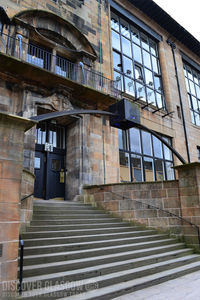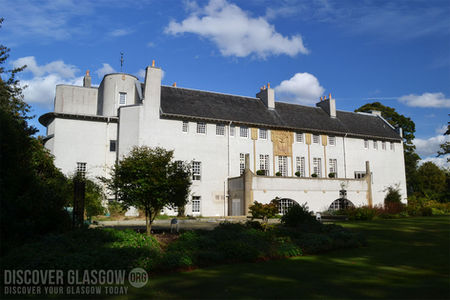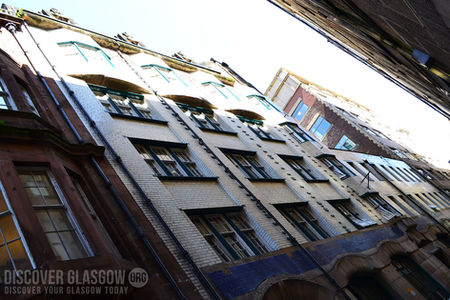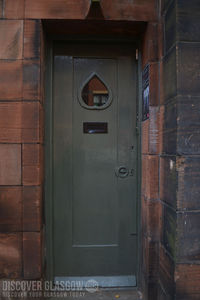CHARLES RENNIE MACKINTOSH
While he is possibly Scotland’s most famous architect and at one point the United Kingdom’s main representative of Art Nouveau, Mackintosh did not design as many buildings as some of his peers. Take a look at some of his historic works. You can also follow our walking tour.
QUICKLINKS
CHARLES RENNIE MACKINTOSH STATUE
The statue is believed to be the first ever one depicting Charles Rennie Mackintosh, architect and son of Glasgow. He is envisioned sitting on one of his high-backed chairs found in his Willow Tearooms.
BASIC INFORMATION
Nearest train/subway
Exhibition Centre station
What3words
Website

wHERE IS IT?
In the Finnieston district, at the corner of Argyle Street and Finnieston Street.
ABOUT
The statue was unveiled in 2018 by then First Minister Nicola Sturgeon, on the 90th anniversary of Mackintosh’s death. The statue was commissioned by the Sanctuary Group and placed on a 2.2 metre plinth their new £60 million estate that saw new and affordable homes created in Anderston.
The statue was designed and sculpted by Andy Scott, whose other works can be seen dotted around the city. He created a clay prototype of the statue before casting it in bronze. The finished statue measures 2.8 metres in height and comes in at a weight of just under three tons.
GALLERY
GLASGOW SCHOOL OF ART
The current home of the Glasgow School of Art, with the main building on Renfrew Street designed by architect Charles Rennie Mackintosh, is in fact the third location of the school.
BASIC INFORMATION
Nearest train/subway
Cowcaddens subway
What3words
Website

wHERE IS IT?
Halfway along Renfrew Street, one up the hill from Sauchiehall Street, a short walk from the GFT.
ABOUT
Originally founded on Ingram Street in 1845 under the title of Glasgow Government School of Design, it then moved to the then-recently built McLennan Galleries 25 years later. Just over a quarter of a century later after that, work began on the Renfrew Street building. Designed by Charles Rennie Mackintosh, who was handpicked by the school’s new director Francis Newbery, the first half was finished in 1899, with the second half finished over a decade later.
The school is separated into three paths of study - Architecture, Design and Fine Arts - and has provided an education and platform for some of the world’s brightest artists and creative souls, including three Turner Prize winners and a third of all nominees in the award’s illustrious history. Notable graduates include actor and director Peter Capaldi, painter Stephen Conroy, Travis members Fran Healy and Dougie Payne, and playwright and poet Liz Lochhead.
Tragedy struck the school not once but twice. In 2014, a fire broke out in the main Mackintosh building. Glasgow firefighters were able to save around three-quarters of the content and believed that 90% of the structure was still intact. However, the library section of the building was lost.
In 2016, Kier Construction was handed the task of restoring the fire-damaged building, working hand-in-hand with Page\Park Architects. Unfortunately, while restoration works were underway, a second fire occurred. Not only did it rip through the Glasgow School of Art, but it also gutted the O2 ABC venue behind it, with the latter building having to be torn down. The cause of the second fire could not be determined.
It is not all doom and gloom though. At the start of 2023, preparations to restore Mackintosh’s building had been completed, with the Glasgow School of Art determined to breathe new life into its walls with a faithful reinstatement of the original building.
In addition, the campus of the Glasgow School of Art was expanded with the Reid Building, which is Phase One of a three-part plan for the school. Sitting across from the Mackintosh building, the final design was settled on after a competition was launched to find a design for the new building in 2009. It was won by New York firm Steven Holt Architects in partnership with Glasgow-based JM Architects. The building was completed in 2014 by Arup and named after the then-director of the Glasgow School of Art, Dame Seona Reid.
GALLERY
house for an art lover
House for an Art Lover was designed by Mackintosh for entry into a German architectural competition run by the publication Zeitschrift für Innendekoration in 1901.
BASIC INFORMATION
Nearest train/subway
St. Enoch / Central station
What3words
Website

wHERE IS IT?
In the centre of Bellahouston Park near Ibrox Stadium and underground station.
ABOUT
Despite the turn of the century design, it was not until the mid-1980s that the original plans were brought to life. It was Glaswegian civil engineer Graham Roxburgh who proposed taking Mackintosh’s original designs and bringing them to life in Bellahouston Park. Construction commenced in 1989, using the materials and techniques that Mackintosh himself would have employed, and was partially completed in 1990, before the economic recession took its tool and halted progress. It remained unfinished until 1994 when the interiors were finished and landscaping began. The House for an Art Lover was finally opened to the public in 1996.
The competition by Zeitschrift für Innendekoration was seeking ‘a Grand Residence for an Art Lover,’ looking for originality in its design. The entry requirements stated that ‘it is permissible and even desirable that an Architect and a Decorative Artist of modern tastes develop and submit the design jointly.’ Luckily for Mackintosh, he was married to an artist, Margaret MacDonald, whom he worked with on this and many of his other projects, most famously the Willow Tea Rooms.
However, Mackintosh’s entry was at first disqualified after he failed to submit all the material, but this was overturned when he submitted additional interior perspectives. He eventually garnered a prize for ‘their pronounced personal quality, their novel and austere form and the uniform configuration of interior and exterior.’
In the modern day, the grounds also show a number of works of art, including ‘Foot and Arch’ by Indian sculptor Ganesh Gohain, and the colourful ‘Jelly Moulds’ by firm One Foot Taller, which were part of a competition to redesign the common park bench.
GALLERY
the lighthouse
Scotland’s national centre for design and architecture is found in the former Glasgow Herald building, designed by Charles Rennie Mackintosh, his first public commission.
BASIC INFORMATION
Nearest train/subway
St. Enoch / Central station
What3words
Website

wHERE IS IT?
In the city centre, halfway along Mitchell Lane, which connects Buchanan Street with Mitchell Street.
ABOUT
The most prominent feature of the structure is a castle-like tower on the corner. Mackintosh built it to include over 8000 gallons of water, an early fire extinguisher system to protect goods inside should the building have ever caught alight (which in Glasgow is always a distinct possibility).
Almost a century after it was built in 1895, and after two decades of lying abandoned, it was renovated and relaunched as The Lighthouse. Due to its Mackintosh heritage, it has a section devoted to the architect and artist’s life and work, as well as the history of the building itself.
As well as hosting other exhibits, The Lighthouse has positioned itself as a central hub for creativity in the city. The centre holds lectures and workshops in a variety of fields. There is also a Digital Design Gallery as well as regular fairs and markets, allowing craft makers to sell their works to the general public.
GALLERY
MARTYRS' PUBLIC SCHOOL
Less famous than Mackintosh’s other designed school located on Scotland Street, the Martyrs’ Public School was built the decade before, in the same area Mackintosh grew up in.
BASIC INFORMATION
Nearest train/subway
High Street station
What3words
Website

wHERE IS IT?
Just north of Cathedral Precinct, directly opposite Glasgow Royal Infirmary.
ABOUT
Over the last century, the Martyrs’ School has changed hands and uses, from its inception as a public school to a primary school after World War II, before briefly becoming part of Stow College until it was taken over by St. Mungo’s Academy. From the 1970s it was an art centre, initially run by the Forum Arts Trust before Glasgow Museums took over the reins. At present it houses Glasgow’s Social Work Leaving Care Services.
Mackintosh’s influence as a senior assistant on the project can be seen, but his role on the project has been embellished due to his later fame, and it is more likely the overall design came from one or both of the founding partners of the firm Honeyman & Keppie, both of whom are named John. As well as his later celebrity, another reason the school is associated with Mackintosh is that it is built on Parson Street, the same street young Charles was born on.
GALLERY
old daily record building
Located up the very narrow Renfield Lane, it is almost impossible to appreciate how this building would look if it did not occupy such a restricted space.
BASIC INFORMATION
Nearest train/subway
Glasgow Central station
What3words
Website

wHERE IS IT?
In the city centre, hidden along Renfield Lane, just one street north of Central Station.
ABOUT
Designed by Charles Rennie Mackintosh, it features some similar concepts used in the construction of another newspaper building by his hand, the Glasgow Herald. The most prominent similarity is the water towers. It was home to the Daily Record from its first issue in 1895 until the paper moved to Hope Street in 1926. It is still possible to see some of the design aspects from the street level, including the mosaic tiles at the top, which will remind the gamers among you of the Triforce from Nintendo’s Legend of Zelda series.
It has since been converted into the highly recommended Stereo Cafe/Bar, music and arts venue and nightclub. They were kind enough to share some sketches they had of how the building looks unobscured.
GALLERY
QUEENS CROSS CHURCH
Queens Cross Church, also known as Mackintosh Queens' Cross, is the only church designed by the famous Glasgow architect that was ever taken beyond the blueprint and actually built.
BASIC INFORMATION
Nearest train/subway
Kelvinbridge subway
What3words
Website

wHERE IS IT?
North west of the city centre, where Maryhill Road and Garscube Road merge into one.
ABOUT
The church was commissioned from the firm Honeyman & Keppie by the Free Church of Saint Matthew in 1896. The site they had chosen was not ideal; it was situated on a corner sandwiched between warehouses and tenement buildings. Perhaps it was for this reason that John Honeyman passed the job onto Mackintosh, at that point only a trainee with the architecture firm.
The church required a simple design, and so rather than the traditional spire dominating the building, Mackintosh elected to employ a Modern Gothic style. The church has a corner tower, which gives the building the look of a fort. These towers were quite common in that period; many have survived and can be seen among Glasgow’s present-day rooftops. Mackintosh would later design a grander tower for the Glasgow Herald Building (now the Lighthouse), which was used in that period as a place to store water in case of fire. In the case of Queens Cross Church, the trainee architect added features to the simple style that would soon become synonymous with the young architect, namely the narrow, stylistic windows, and the curved heart shapes embedded in the doors and pulpits.
The church itself was decommissioned in the 1970s, with the congregation merging with that at Ruchill Parish (which adjoins another Mackintosh building, Ruchill Hall). In 1977 the Charles Rennie Mackintosh Society made Queens Cross their headquarters. In 1999, Dr. Thomas Howarth, Mackintosh’s first biographer, made a generous donation that allowed the CRMS to buy the building outright. Their benefactor said the church possesses “a warmth and charm conspicuously absent from many churches of the period due largely to the traditional simplicity of Mackintosh’s architectural forms and to the mysticism and spirituality of his decorative motives.”
GALLERY
ROYAL HIGHLAND FUSILIERS REGIMENTAL MUSEUM
Hidden on the lower end of Sauchiehall Street, sandwiched between a disused shop and a nightclub, is the Royal Highland Fusiliers Museum.
BASIC INFORMATION
Nearest train/subway
Charing Cross
What3words
Website

wHERE IS IT?
At the lower end of Sauchiehall Street, five minutes walk from the Art School.
ABOUT
The RHF Regimental Museum is a short walk from Mackintosh's more famous building, the Glasgow School of Art. While this museum is significantly smaller, the RHF staff make good use of the space inside. You will leave there well-informed about the history of these three-hundred-year-old Scottish warriors, and possibly carrying a tartan trinket of some kind as well.
The exterior is of Victorian red sandstone and was built as an extension to the original building that existed there, Albany House, of which little is left. As well as Mackintosh’s indulgent swirls embedded in the design, he has included the RHF letters, partitioned by two statues, male and female, staring down upon the street. Above them is the RHF golden cap badge, holding three flags, colours of three battle honours awarded to the Royal Highland Fusiliers.
GALLERY
RUCHILL CHURCH HALL
While not as grand as some of Mackintosh's later works, Ruchill Church Hall exemplifies the architect's unique style and his trademark art nouveau motifs litter the building.
BASIC INFORMATION
Nearest train/subway
Kelvinbridge subway
What3words
Website

wHERE IS IT?
North West of the city centre, located on Shakespeare Street, near the intersection with Maryhill Road.
ABOUT
These recognisable traits, such as the stained glass windows and flower patterns embedded in the doors, are pure Mackintosh. In many respects the design is similar to that of the Art School, although on a much smaller scale; the hall is dwarfed by the Ruchill Kelvinside Parish Church adjacent to it. Completed in 1899, the hall was originally designed as a mission space for the then Free Church of Scotland and has changed very little since. The adjacent church, Ruchill Kelvinside Parish, was built six years later in 1905, to accommodate the large congregations that gathered in the hall. The lack of modernisation allows visitors to see the building as it was a century ago. The Parish Church use the hall for meetings and also run a Mackintosh Tea Room so you can have a cup of tea while enjoying the architecture.
GALLERY
SCOTLAND STREET SCHOOL
Mackintosh famously fought with the school board over the design of Scotland Street School, considered to be one of his finest works.
BASIC INFORMATION
Nearest train/subway
Shields Road subway
What3words
Website

wHERE IS IT?
In the south side near Shields Road underground station.
ABOUT
For his second school project after Martyrs School, Mackintosh based his design on Falkland Palace in Fife and Rowallan Castle in Ayrshire. While the school governors wished for something more modest and less expensive, Mackintosh wanted to design a palace of education that pupils would be proud to attend. They did so for almost seventy years, from the school’s creation in 1906 to its closure in 1973. It was shut down due to low pupil numbers caused by the decay of the surrounding area.
The school later reopened as a museum, with a room devoted to its illustrious designer. As well as exhibits on education throughout the ages, the school museum is infamous amongst Glaswegians for its role-playing experience, where you are dressed as a pupil of yesteryear and forced to listen to a lesson by a stern schoolmistress. Many often end up in the corner wearing the dunce hat. The museum is free, but a little out of the way, and with the car park being a tad expensive, we highly recommend either the subway, with Shields Road station located just outside, or First Bus 89 or 90 (just ask the driver, they’ll know where you are going).
GALLERY
TOWNHEAD PUBLIC MEMORIAL
There are a number of different works created in tribute to Mackintosh that link together along the footpath that cuts through the Townhead area where the architect grew up.
BASIC INFORMATION
Nearest train/subway
Queen Street station
What3words
Website
None

wHERE IS IT?
In the Townhead area, immediately east of the Buchanan Bus Station, accessed via North Hanover Street.
ABOUT
Arguably the most stunning is the Townhead Tree, a stainless steel sculpture crafted by Liz Peden as part of the Gorbals Art Project. The reflective surface of the metallic tree is transformed at night by lights which change colour over time.
Next is a large black marble circle, of which very little is known, with the double-ring crowned posts surrounding it being the only link to Mackintosh. These posts can be found surrounding a monolithic black slab of marble with a teardrop cut out, one of Mackintosh’s signature shapes. Below it is a poetic quote from the man himself. “Without you, everything has a flatness. I feel as if I’m waiting for something all the time.”
GALLERY
THE WILLOW TEAROOMS
Designed by Mackintosh and built in 1903, the Willow Tearooms are one of four tearooms that had the architect’s involvement, usually with the aid of his wife, Margaret MacDonald.
BASIC INFORMATION
Nearest train/subway
Buchanan Street subway
What3words
Website

wHERE IS IT?
The remaining two tearooms are located on Buchanan Street and Sauchiehall Street.
ABOUT
The tearooms were the brainchild of Catherine Cranston, the daughter of a tea merchant and follower of the temperance movement. She became a patron of Mackintosh so he may design the tearooms; places where people could escape Glasgow’s drinking culture and enjoy non-alcoholic refreshments in a variety of rooms within the same building.
The most famous of these is the Willow Tearooms on Sauchiehall Street, a short stroll from Mackintosh’s most famous building, The Glasgow School of Art. A second Willow Tearooms exists on Buchannan Street, around the corner from The Lighthouse, another Mackintosh design. The third, the Crown Luncheon Room, is now Cranston House, a series of storefronts including Schuh and TMobile, and home to Sloans weekend market and bar. The last, Miss Cranston’s Tearooms on Ingram Street, was bought by Glasgow Corporation in the 1950s to be used as a store room and was eventually demolished twenty years later. However, Glasgow Museums managed to save many of the artefacts and interiors, although they are not currently on display.
The Willow Tearooms was formerly a warehouse found on Sauchiehall Street. Mackintosh and his wife Margaret took their inspiration from the street name, with ‘Sauch’ meaning willow in the Lowland Scots language. It included a number of different rooms, chief among them the Room de Luxe; a more expensive tearoom decorated in purple and grey. It features the typical high-back Mackintosh chairs, and while the walls were white, one was decorated by Margaret MacDonald’s famous gesso panel, which was inspired by the sonnet “O Ye, All Ye That Walk in Willow Woods” by English poet Dante Gabriel Rossetti. The exterior reveals Mackintosh’s early flirtations with Art Nouveau, including the slightly curved bay window for the Room de Luxe on the second floor.






































































